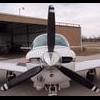After 3 months of putting around local airports, I finally took my new-to-me 201 out to see what she had. I went from Bulverde, TX to KNEW to KSHV, then back home. Flying at 11,500, I planned on coming down at 500fpm to 1,500 into KNEW. Doing 3 mile/min over the ground and needing 20 minutes to get down, I asked for lower about 70 miles out. I had been set at 21"/2500RPM (180mph TAS and just under 10 gal/hr....love that!!!) at cruise and was advised to only pull about 1"/2-3 minutes to avoid shock cooling. My CHTs had all been 320-350. When I pulled out that first inch, I didn't get much of a descent rate so I decided to bring back the RPM as well. After a couple of minutes, I pulled more throttle but when I started to get a good descent rate I noticed that the #1 cylinder jumping between 290 and 320 so I added power to keep it above 300. I know that I could have just pushed the nose down, but I'm trying to learn the engine better. So I guess my question would be...how is shock cooling defined?

